
Introduction
AI in Transportation Statistics: One of the important trends in the worldwide adoption of AI in the transportation industry is the growing adoption of autonomous vehicles. The Technology industry and automakers have invested on a large scale in developing and researching self-driving vehicles. These concentrate on the growth of advanced AI systems that can process sensor information to get to know objects and show through traffic without human interference.
The increase in connectivity and autonomous vehicles can change transportation and increase demand for AI technologies in the application of such innovative driver assistance systems, autonomous passenger cars, and commercial vehicles. With autonomous vehicles, technological advancements are expected to become mainstream. We shall shed more light on AI in Transportation Statistics through this article.
Editor’s Choice
- The worldwide automotive industry’s demand for AI technologies was $2.3 billion in 2022 and is estimated to increase to $7.0 billion by 2027.
- AI-based predictive maintenance can help businesses cut vehicle repair costs by 10–20%. It helps catch problems early, so vehicles break down less often and last longer.
- Using AI to plan routes can lower pollution by 22% for cities trying to become cleaner and greener.
- AI does more than follow time trends; it also finds patterns in different parts of the city.
- 14,00 and more driverless vehicles are presently in the testing process.
- Almost 3 million miles have been logged by using Tesla’s Autopilot version, which uses artificial intelligence.
- Apple has logged almost 5,00,000 miles in California in a single year.
- The global market for driverless vehicles is growing at a yearly rate of 16%.
- By 2030, around 58 million self-driving cars are expected to be sold.
- The worldwide autonomous vehicle industry will be worth nearly $450 million by 2035.
- The worldwide autonomous vehicles industry is predicted to reach $40 billion by 2023, as North America has 30% of all self-driving vehicles worldwide.
- Around 53% of people are okay with using slow, short-distance travel options, such as monorails at airports or theme parks.
- About 55% of Americans think that by 2029, most vehicles will be able to drive independently. But this estimate might be too hopeful, considering the large number of regular cars still on the roads today.
AI in Transportation Market Size
- The Global AI in Transportation Market is expected to reach USD 21.4 Billion by 2033, growing from USD 3.6 Billion in 2023, at a CAGR of 19.5% during 2024 to 2033.
- In 2023, the Software segment accounted for over 42.7% of the total market, driven by demand for intelligent transportation management systems.
- Machine Learning technology dominated the AI in transportation sector in 2023, with a market share of 45.1%, owing to its role in route optimization, predictive maintenance, and traffic flow management.
- The Autonomous Vehicles segment held a market share of 38% in 2023, supported by safety regulations and technological progress.
- North America led the global market in 2023, securing more than 36.5% of the total market share in AI transportation.
- Investments in AI transportation solutions rose to USD 6.2 Billion in 2023, marking a 25% increase compared to the previous year.
- The freight industry is projected to save approximately USD 100 Billion annually through the adoption of AI-driven autonomous trucks.
- Global AI-related funding amounted to USD 5.4 Billion in Q1 2023, although this reflected a 43% decline from the previous quarter.
- Despite the funding dip, over 25% of all U.S. startup investment in 2023 was allocated to AI-related companies.
- The overall Global Artificial Intelligence Market is projected to grow from USD 177 Billion in 2023 to approximately USD 2,745 Billion by 2032, with a CAGR of 36.8% from 2024 to 2033.
- By 2030, it is estimated that 15% of all new cars sold will be fully autonomous, powered by AI technologies.
- AI and digitization initiatives in urban transport could potentially reduce 225 million metric tons of CO2 emissions by 2030.
- The transportation sector contributed USD 561.90 Billion to the U.S. economy in Q1 2023.
- Household transportation expenditures accounted for 13.2% of family budgets in the United States.
- By 2023, 78% of logistics companies were expected to offer same-day delivery through AI-enabled route planning and scheduling.
- It is projected that 85% of supply chain interactions would be automated by 2021 through AI integration.
- AI investments in transportation were projected to grow by 12% annually until 2023.
- According to industry insights, 83% of transportation and logistics businesses believe AI offers a significant competitive advantage.
Artificial Intelligence in Transforming Mobility Statistics
- Statista reports that by 2030, there could be about 58 million autonomous vehicles on the roads. This shows how fast self-driving tech is growing and becoming part of daily life.
- Smart traffic systems powered by AI can reduce road congestion by 25%. That means fewer traffic jams, shorter travel times, and lower pollution, making cities cleaner and more efficient.
- According to AI in Transportation statistics, Wikipedia states that the use of AI solutions has grown significantly, with an average annual growth rate of about 24.1% over the past five years.
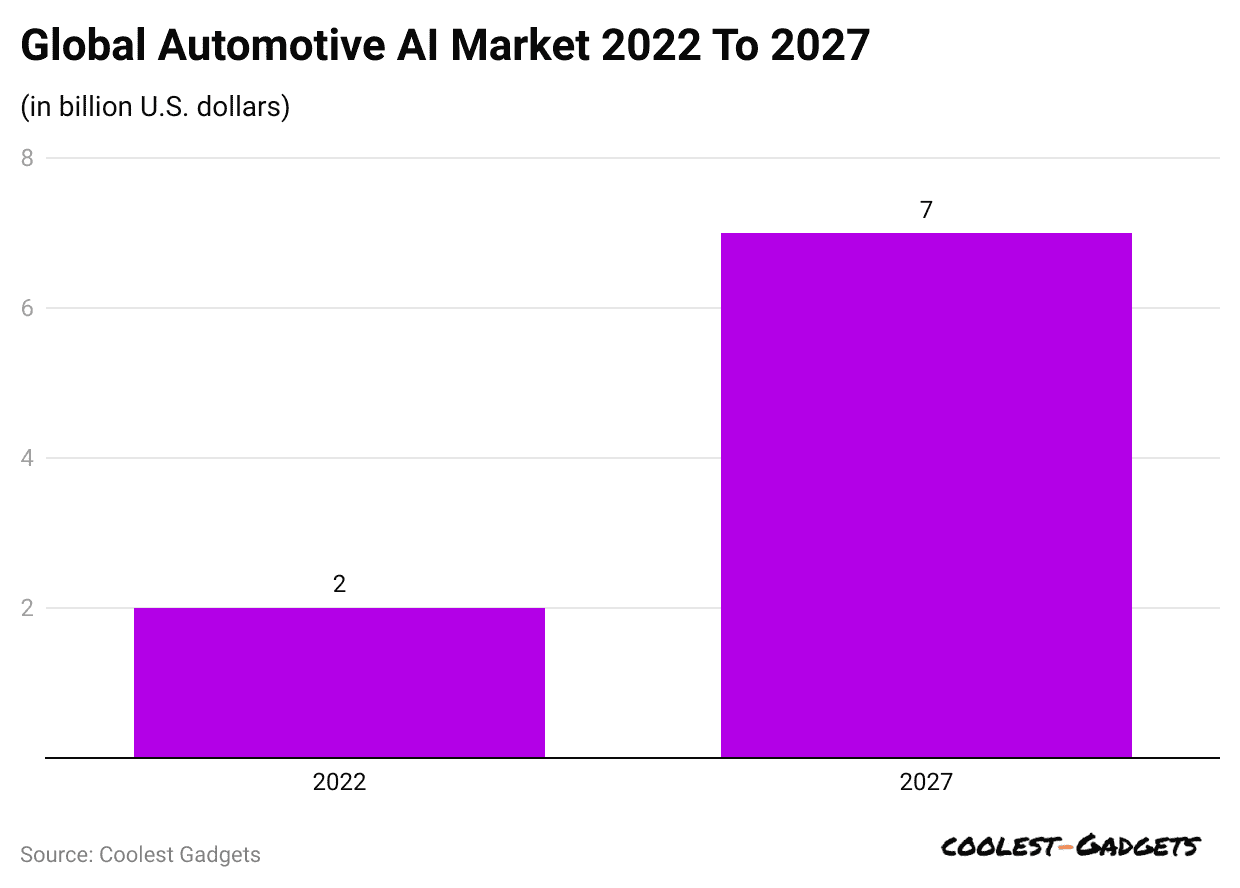 (Reference: prismetric.com)
(Reference: prismetric.com)
- The Global Automotive AI Market was valued at $2.0 billion in 2022 and is predicted to grow to $7.0 billion by 2023.
- AI-based predictive maintenance can help businesses cut vehicle repair costs by 10–20%. It helps catch problems early, so vehicles break down less often and last longer.
- AI can help plan better driving routes, reducing fuel usage by as much as 15%. This saves money and helps the environment by lowering emissions.
- Cars that use AI to monitor driver behaviour can reduce accidents by 20–30%. These smart safety systems help keep drivers, passengers, and others on the road safer.
Fuel Consumption Reduction Statistics
 (Reference: artsmart.ai)
(Reference: artsmart.ai)
The above chart shows us the Impact of AI on Fuel Consumption and Carbon Emissions:
| Impact of AI on Fuel Consumption and Carbon Emissions | % reduction |
|
Carbon Emission Reduction |
22% |
| Fuel Consumption in Logistics |
20% |
- Market data forecast says that smart vehicles using AI can lower fuel use by up to 20%, which helps drivers spend less money on gas and cut down their fuel bills.
- Smart cruise control powered by AI can boost gas mileage by as much as 15%, especially during long trips.
- AI-based tools that predict when a car needs repair can reduce the time a vehicle is out of service by almost 45%, keeping it running more effectively.
- Using AI to plan routes can lower pollution by 22% for cities trying to become cleaner and greener.
AI and Autonomous Vehicles Statistics
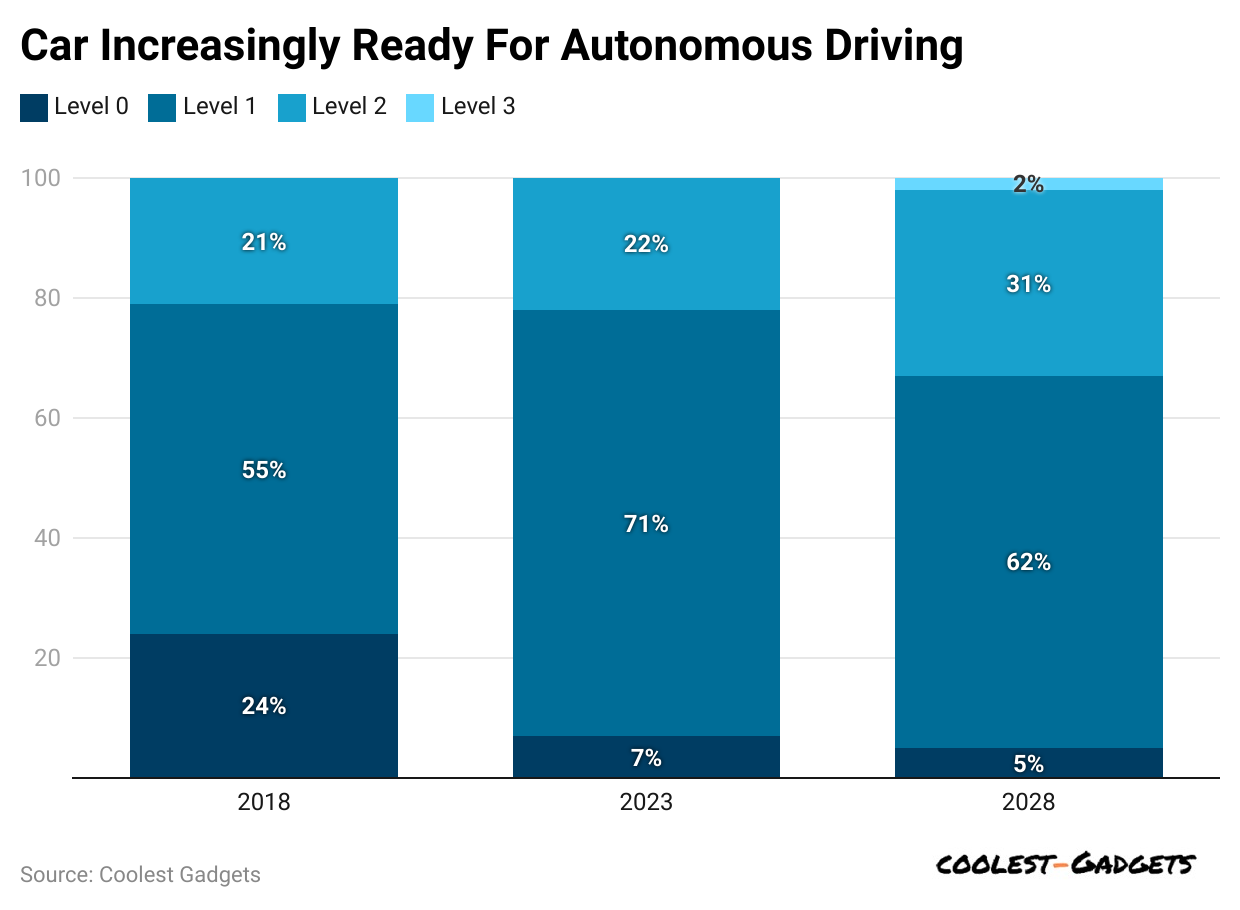 (Reference: statista.com)
(Reference: statista.com)
- The above chart shows us the rate of increase of autonomous driving cars from 2018:
| 2018 | 2023 | 2028 | ||
|
Level 0 |
Autonomous driving | 24% | 7% | 5% |
| Level 1 | Partly assisted driving (steering or braking) | 55% | 71% |
62% |
|
Level 2 |
Assisted driving (steering and braking below 60km/hr | 21% | 22% | 31% |
| Level 3 | Highly autonomous driving | – | – |
2% |
- As per AI in Transportation Statistics from the Business Research Company, about 26,560 self-driving cars were being used around the world. That number is expected to grow to 33,570 by 2025, which is a 26% increase from the year before.
- In 2025, almost 15% of all new passenger cars sold will have a highly advanced self-driving feature.
- Almost 6,140 businesses are currently working on self-driving car technology.
- Nearly 1,162 new tech startups are developing autonomous vehicle systems.
- More than 37,000 patents have been filed in the autonomous vehicles industry.
- Almost 1,790 research grants have been awarded to support the growth of this technology.
AI in Traffic Control Systems
- The global AI in traffic management market is projected to grow from $20.65 billion in 2024 to $27.44 billion in 2025, that reflects a CAGR of 32.9%.
- AI is helping improve how cities handle traffic. By checking live traffic data, AI can adjust 100% of traffic lights and guide vehicles to less crowded streets.
- AI algorithms can predict traffic patterns with a accuracy of 92%.
- Some cities like Taichung, Vienna, York, and Rome already use smart tools like PTV’s real-time system, which combines AI with live traffic models.
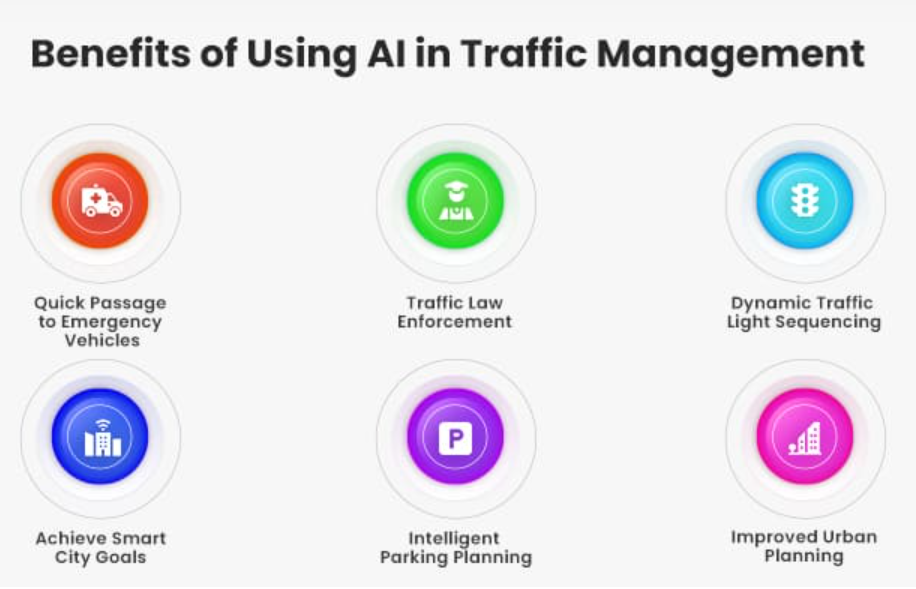 (Source: matellio.com)
(Source: matellio.com)
- One of these tools, PTV Optima, gives traffic teams predictions up to 60 minutes ahead.
- In 2025, it is predicted that 70% of the developed cities will employ AI for traffic monitoring.
- It helps them plan for roadwork, closures, or traffic build-up before it becomes problematic.
 (Reference: artsmart.com)
(Reference: artsmart.com)
| AI Traffic Prediction Models | 90% |
|
AI Traffic Flow Optimization |
30% |
| AI Traffic Management System |
25% |
- The above chart shows the impact of AI on traffic management and predictions.
- AI-powered traffic system aims to reduce carbon emissions by 10% to 15%.
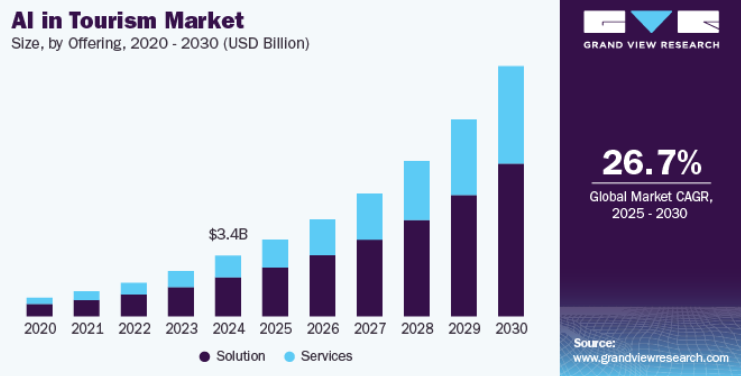 (Source: grandviewresearch.com)
(Source: grandviewresearch.com)
- The above chart shows AI in the Tourism Market from 2020 to 2030, in USD billion.
- In 2024, the global market for AI in Tourism was worth around $2.95 billion.
- It is expected to reach almost $13.38 billion by 2030, growing at a yearly rate of 28.7%.
- The market for AI in hospitality and transport is expected to grow from $15.70 billion in 2024 to $20.50 billion in 2025.
- According to AI in Transportation Statistics from PS Market Research, almost 65% of travel businesses globally plan to increase their expenses on AI tools within the next two years.
AI in Delivery and Logistics
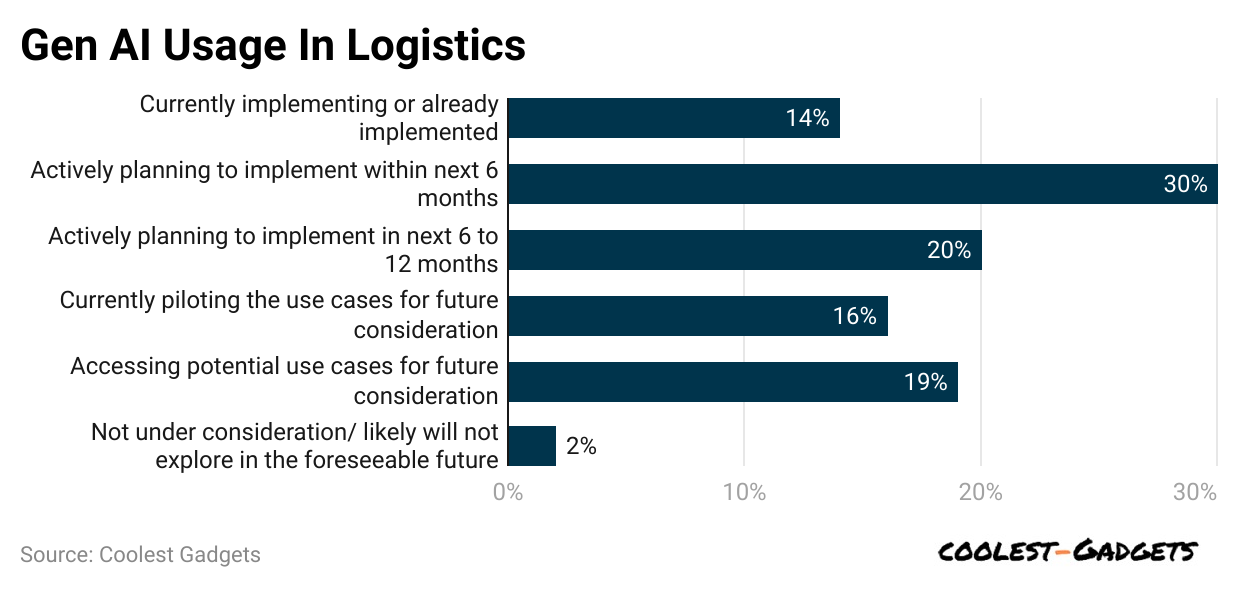 (Reference: apurple.com)
(Reference: apurple.com)
| Currently implementing or already implemented | 14% |
| Actively planning to implement within the next 6 months |
30% |
|
Actively planning to implement in the next 6 to 12 months |
20% |
| Currently piloting the use cases for future considerations |
16% |
|
Assessing potential use cases for future consideration |
19% |
| Not under consideration/ likely will not explore in the foreseeable future |
2% |
- AI is changing the way goods are delivered. In 2024, smart systems that plan delivery routes helped speed up shipments by up to 25% and reduced fuel expenses by around 15%.
- These savings are expected to grow by 2025, helping companies save nearly $10 billion each year on fuel and other delivery costs.
- AI checks traffic patterns, road conditions, and weather forecasts to pick the quickest and most fuel-efficient route. This speeds up deliveries and cuts pollution, reducing carbon emissions by about 12% in 2024 and possibly reaching 18% by 2025.
- In 2024 and 2025, businesses say that experienced dispatchers help deal with surprises and last-minute route changes, boosting delivery success rates by 8–10%.
AI Adoption in Transportation Statistics
- Artificial intelligence (AI) can help cut transportation costs by as much as 15%, especially by predicting weather and other conditions.
- By 2030, AI could help save up to $60 billion annually in transportation. That’s a big amount of money that companies can use to offer better services or invest in new technology.
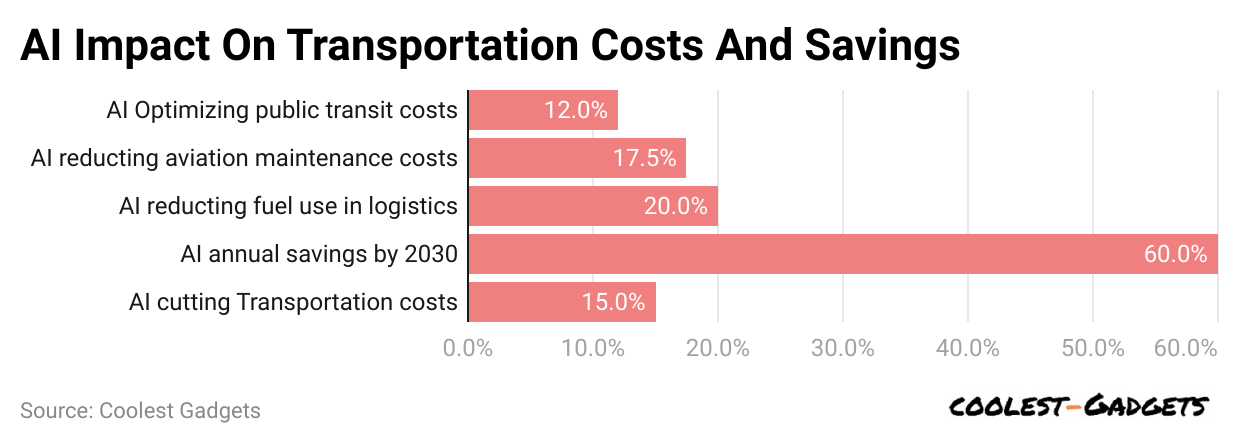 (Reference: artsmart.ai)
(Reference: artsmart.ai)
| AI Optimising Public Transit Costs | 12.0% |
| AI Reducing Aviation Maintenance Costs |
17.5% |
|
AI Reducing Fuel Use in Logistics |
20.0% |
| AI Annual Savings by 2030 |
$60.0 billion |
|
AI Cutting Transportation Costs |
15.0% |
The chart explains how artificial intelligence (AI) is helping lower transportation expenses in different ways:
- Public Transit Savings (12%): AI is helping city buses and trains run more efficiently, reducing operating costs by about 12%.
- Lower Aircraft Maintenance Costs (17.5%): AI can spot technical problems early and help schedule repairs better, reducing the cost of maintaining aeroplanes by 17.5%.
- Less Fuel Use in Shipping (20%): AI helps plan better delivery routes and manage vehicles more effectively, which cuts fuel use in logistics by 20%.
- Overall Drop in Transportation Costs (15%): AI is expected to reduce total transportation expenses by 15% across the industry.
- Yearly Savings by 2030 ($60 billion): These AI improvements could lead to yearly savings of around $60 billion in the transportation industry by 2030.
Benefits of AI in Transportation
When added to different transport systems, AI brings many benefits:
#1. Safer Driving and Fewer Accidents
- AI systems can warn drivers about dangers and give real-time traffic alerts. Since many crashes happen due to human mistakes, AI can watch for unsafe actions and help drivers fix them.
- The U.S. Department of Transportation says 3,308 people died from distracted driving in 2023.
#2. Smoother Traffic and Less Congestion
- AI improves how cities handle traffic. It controls smart traffic lights, predicts how long trips will take and helps manage traffic better, leading to fewer traffic jams.
#3. Business Savings and Higher Efficiency
- Companies can save money using AI for route planning, vehicle checkups, and traffic control.
- AI looks at traffic, road issues, and stops to choose the fastest and most fuel-saving routes.
- This can lead to up to 30% savings in fuel, time, and labor costs.
#4. Better Experience for Customers
- AI tools like self-driving features and real-time tracking make trips safer and more reliable.
- Drivers get help staying alert, and delivery services become more accurate with on-time arrivals.
#5. Lower Emissions and Cleaner Cities
- AI helps the environment by cutting down the time cars spend stuck in traffic or looking for parking.
- In some German cities, people spend around 41 hours a year searching for parking.
- Smart AI tools can guess where parking is available, helping drivers park faster and reducing pollution from driving around.
Conclusion
Artificial intelligence transforms transport by introducing various technologies and evolutions in road, rail and air transport. From autonomous vehicles to predictive maintenance, artificial intelligence impacts how we move, defining old procedures and boosting effectiveness. Introducing AI in transportation promises an advancement in safety, reduction in costs and reduction in traffic congestion. Higher authorities and transportation industries are integrating Artificial Intelligence into various workflows and must have clear roadmaps.
They shall foster partnerships and invest in the infrastructure to address user problems. Artificial Intelligence projects must state user concerns. Transport is a key part of today’s world, and we can expect more new ideas in the future. But for people to fully accept AI in this area, it must protect privacy, follow the law, and meet other important standards.
How is AI used in public transportation?
A protected method and AI algorithm are used to estimate how crowded a vehicle will be. It compares real-time passenger numbers from the system with past data on how many people usually get on and off at the next stop.
How is AI being used in vehicles?
AI-based systems use built-in sensors to support steering, detect people walking nearby, and check areas the driver can’t see. These systems send alerts so drivers can act early and avoid road accidents. This technology quickly becomes a standard part of smart vehicles, improving safety and comfort.

Barry Elad
Barry Elad is a tech enthusiast passionate about exploring various technology topics. He collects key statistics and facts to make tech easier to understand. Barry focuses on software and its benefits for everyday life. In his free time, he enjoys creating healthy recipes, practicing yoga, meditating, and walking in nature with his child. Barry’s mission is to simplify complex tech information for everyone.






